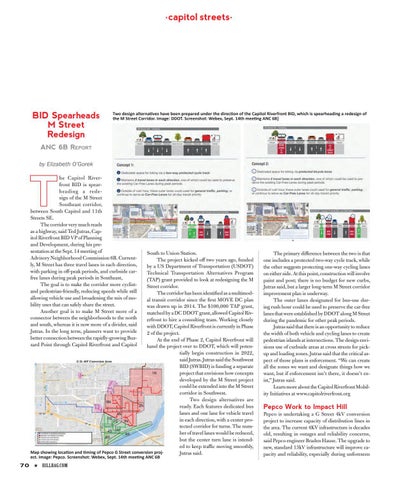.capitol streets.
BID Spearheads M Street Redesign
Two design alternatives have been prepared under the direction of the Capitol Riverfront BID, which is spearheading a redesign of the M Street Corridor. Image: DDOT. Screenshot: Webex, Sept. 14th meeting ANC 6B]
ANC 6B Report by Elizabeth O’Gorek
T
he Capitol Riverfront BID is spearheading a redesign of the M Street Southeast corridor, between South Capitol and 11th Streets SE. The corridor very much reads as a highway, said Ted Jutras, Capitol Riverfront BID VP of Planning and Development, during his presentation at the Sept. 14 meeting of Advisory Neighborhood Commission 6B. Currently, M Street has three travel lanes in each direction, with parking in off-peak periods, and curbside carfree lanes during peak periods in Southeast, The goal is to make the corridor more cyclistand pedestrian-friendly, reducing speeds while still allowing vehicle use and broadening the mix of mobility uses that can safely share the street. Another goal is to make M Street more of a connector between the neighborhoods to the north and south, whereas it is now more of a divider, said Jutras. In the long term, planners want to provide better connection between the rapidly-growing Buzzard Point through Capitol Riverfront and Capitol
South to Union Station. The project kicked off two years ago, funded by a US Department of Transportation (USDOT) Technical Transportation Alternatives Program (TAP) grant provided to look at redesigning the M Street corridor. The corridor has been identified as a multimodal transit corridor since the first MOVE DC plan was drawn up in 2014. The $100,000 TAP grant, matched by a DC DDOT grant, allowed Capitol Riverfront to hire a consulting team. Working closely with DDOT, Capitol Riverfront is currently in Phase 2 of the project. At the end of Phase 2, Capitol Riverfront will hand the project over to DDOT, which will potentially begin construction in 2022, said Jutras. Jutras said the Southwest BID (SWBID) is funding a separate project that envisions how concepts developed by the M Street project could be extended into the M Street corridor in Southwest. Two design alternatives are ready. Each features dedicated bus lanes and one lane for vehicle travel in each direction, with a center protected corridor for turns. The number of travel lanes would be reduced, but the center turn lane is intended to keep traffic moving smoothly, Map showing location and timing of Pepco G Street conversion projJutras said. ect. Image: Pepco. Screenshot: Webex, Sept. 14th meeting ANC 6B
70 H HILLRAG.COM
The primary difference between the two is that one includes a protected two-way cycle track, while the other suggests protecting one-way cycling lanes on either side. At this point, construction will involve paint and post; there is no budget for new curbs, Jutras said, but a larger long-term M Street corridor improvement plan is underway. The outer lanes designated for bus-use during rush hour could be used to preserve the car-free lanes that were established by DDOT along M Street during the pandemic for other peak periods. Jutras said that there is an opportunity to reduce the width of both vehicle and cycling lanes to create pedestrian islands at intersections. The design envisions use of curbside areas at cross streets for pickup and loading zones. Jutras said that the critical aspect of those plans is enforcement. “We can create all the zones we want and designate things how we want, but if enforcement isn’t there, it doesn’t exist,” Jutras said. Learn more about the Capitol Riverfront Mobility Initiatives at www.capitolriverfront.org
Pepco Work to Impact Hill Pepco is undertaking a G Street 4kV conversion project to increase capacity of distribution lines in the area. The current 4KV infrastructure is decades old, resulting in outages and reliability concerns, said Pepco engineer Braden Hause. The upgrade to new, standard 13kV infrastructure will improve capacity and reliability, especially during unforeseen












